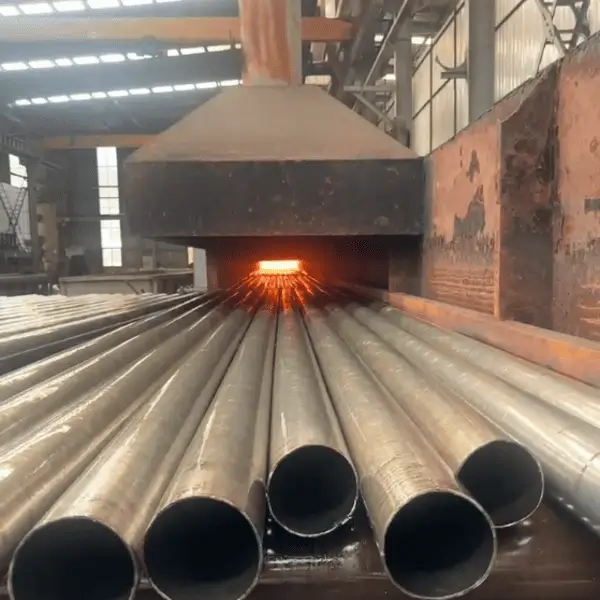1. Introduction to Stainless Steel Pipe Annealing
Stainless steel pipes are integral to modern infrastructure, serving critical roles in industries such as oil and gas, chemical processing, construction, and pharmaceuticals. Their popularity stems from exceptional corrosion resistance, mechanical strength, and versatility. However, manufacturing processes like welding, bending, or cold working often compromise these properties by introducing residual stresses, microstructural defects, or reduced corrosion resistance. Stainless steel pipe annealing—a controlled heat treatment process—addresses these issues by restoring the material’s optimal characteristics. This article delves into the annealing processes for three key stainless steel grades: duplex stainless steel pipe annealing, 316L stainless steel pipe annealing, and 304 stainless steel pipe annealing. Each alloy demands unique annealing parameters to balance phase distribution, mechanical performance, and corrosion resistance.
Stainless Steel Pipe Annealing Video1
2. Fundamentals of Stainling Steel Annealing
2.1 Purpose of Annealing
Annealing involves heating stainless steel pipes to a specific temperature, holding them at that temperature (soaking), and cooling them under controlled conditions. The goals include:
Stress Relief: Eliminating internal stresses from fabrication.
Grain Refinement: Achieving uniform microstructure.
Ductility Restoration: Counteracting work hardening.
Corrosion Resistance: Rehomogenizing chromium distribution to prevent carbide precipitation.
2.2 Key Parameters
Temperature: Varies by alloy (e.g., 1,040–1,120°C for austenitic grades).
Soaking Time: Ensures temperature uniformity (typically 30–60 minutes).
Cooling Rate: Critical to avoid sensitization (e.g., rapid cooling for austenitic steels).
3. Duplex Stainless Steel Pipe Annealing
3.1 Material Overview
Duplex stainless steels (e.g., UNS S31803, S32205) combine austenitic (γ) and ferritic (α) phases, offering:
High Strength: Double the yield strength of 304/316L.
Stress Corrosion Cracking Resistance: Ideal for aggressive environments.
Phase Balance Challenges: Improper annealing disrupts the 50:50 γ/α ratio.
3.2 Annealing Process
Temperature Range: 1,020–1,120°C to dissolve secondary phases (e.g., sigma, chi).
Soaking Time: 30 minutes per 25 mm thickness.
Cooling: Rapid quenching (water or air) to retain 40–60% austenite.
Case Study: Offshore oil pipelines using duplex stainless steel pipes annealed at 1,080°C exhibited a 30% reduction in pitting corrosion compared to non-annealed counterparts.
3.3 Common Pitfalls
Sigma Phase Formation: Occurs below 950°C, embrittling the material.
Overheating: Causes excessive ferrite content (>60%), reducing toughness.
4. 316L Stainless Steel Pipe Annealing
4.1 Material Overview
316L, a low-carbon austenitic stainless steel, is favored in marine and chemical applications due to:
Molybdenum Addition: Enhances chloride resistance.
Sensitization Risk: Carbon content (≤0.03%) minimizes carbide precipitation.
4.2 Annealing Guidelines
Temperature: 1,010–1,120°C to dissolve carbides and homogenize microstructure.
Cooling Rate: Rapid quenching (<3 minutes from 870°C to 540°C).
Post-Treatment: Pickling or passivation to restore the chromium oxide layer.
Industry Example: Pharmaceutical-grade 316L pipes annealed at 1,070°C met ASTM A312 standards with zero intergranular corrosion failures over five years.
4.3 Challenges
Sensitization in Welds: Requires post-weld annealing at 1,050°C.
Oxidation: Scaling on pipe surfaces necessitates controlled atmosphere furnaces.
5. 304 Stainless Steel Pipe Annealing
5.1 Material Overview
304 stainless steel, the most widely used austenitic grade, is valued for:
Cost-Effectiveness: No molybdenum content.
Work Hardening: Prone to hardening during forming.
5.2 Annealing Process
Temperature: 1,040–1,120°C to recrystallize the microstructure.
Cooling: Air cooling for thin sections; water quenching for thick walls.
Stress Relief: Subcritical annealing (425–550°C) for welded joints.
Application Insight: HVAC systems using annealed 304 pipes saw a 25% increase in lifespan due to eliminated stress corrosion cracks.
5.3 Key Considerations
Carbide Precipitation: Avoid slow cooling between 425–850°C.
Dimensional Stability: Fixture pipes during annealing to prevent warping.
6. Comparative Analysis of Annealing Techniques
Parameter | Duplex Stainless Steel | 316L Stainless Steel | 304 Stainless Steel |
|---|---|---|---|
Optimal Temperature | 1,020–1,120°C | 1,010–1,120°C | 1,040–1,120°C |
Cooling Method | Water/Air Quench | Rapid Quench | Air/Water Quench |
Critical Risk | Sigma Phase Formation | Sensitization | Work Hardening |
Key Benefit | Phase Balance | Carbide Dissolution | Stress Relief |
7. Challenges in Industrial Annealing
7.1 Oxidation and Scaling
- Issue: High-temperature exposure forms chromium-depleted oxide layers.
- Solution: Use inert gas (argon/nitrogen) or vacuum furnaces.
7.2 Distortion Control
- Issue: Uneven heating/cooling causes warping.
- Solution: Optimize furnace loading and employ automated quenching systems.
7.3 Energy Efficiency
- Issue: High energy consumption in batch annealing.
- Solution: Adopt induction annealing for localized, rapid heating.
8. Innovations in Annealing Technology
8.1 Laser Annealing
- Application: Precision annealing for thin-walled or small-diameter pipes.
- Advantage: Minimal heat-affected zone (HAZ) and reduced oxidation.
8.2 Induction Annealing
- Application: Large-diameter pipes in oil and gas.
- Advantage: Energy savings of up to 40% compared to traditional methods.
8.3 AI-Driven Process Optimization
- Application: Real-time monitoring of temperature and cooling rates.
- Advantage: Predictive adjustments to prevent defects.
9. Conclusion
Stainless steel pipe annealing is a nuanced process tailored to the unique requirements of each alloy. Duplex stainless steel pipe annealing prioritizes phase equilibrium to maintain strength and corrosion resistance, while 316L stainless steel pipe annealing focuses on preventing sensitization in chloride-rich environments. For 304 stainless steel pipe annealing, stress relief and work hardening reversal are paramount. As industries demand higher performance and sustainability, advancements like laser annealing and AI-driven controls are revolutionizing traditional methods. By understanding the interplay between material properties and annealing parameters, manufacturers can ensure stainless steel pipes meet the rigorous demands of modern applications.

